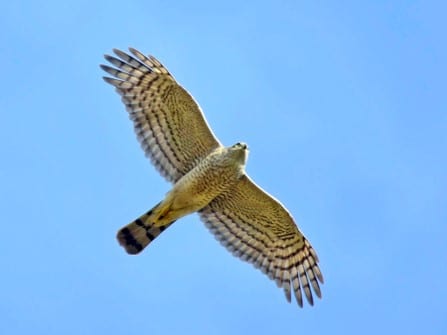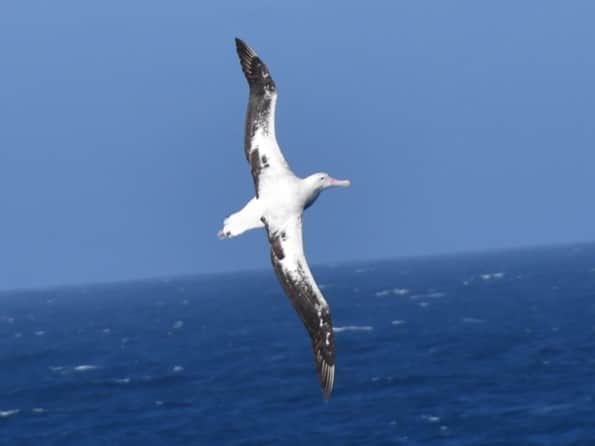The development of foils is moving fast. One foil looks even more futuristic than the other. How do you determine the properties of the foil/wingset and which wingset suits you? In this article, we will explain which aspects of wing design (front wings and stabilizers (or back wings)) make the most important contribution to the properties of a foil. This article was created in part because of the input we received from topshaper Tiesda You of Starboard Foils.
Scientific insight into wing design foils
The principle of wing foiling and wind foiling is basically the same as with airplanes. Many of the laws of physics (aerodynamics) that apply in the air also apply in the water (hydrodynamics). Wind foiling broke through in 2017 and wing foiling shortly after. In the prestigious American Cup, they have been sailing with boats equipped with foils since 2013.
The wingfoil and wind foil industry is happy to make use of the knowledge and insights gained in this ‘F1 of sailing’. Starboard has a close collaboration with Martin Fischer who is responsible for the development of the foils of Amercian Cup teams.
We can clearly see this ‘leap’ in knowledge in the latest generations of Starboard foils. We also see other brands making huge strides with the latest generations of foils.
Basic aspects of wing shapes
Let’s take a closer look at the basic shapes of wings. This teaches you to better assess what basic characteristics a type of wing has and whether it suits your style and level of foiling. We pay the most attention to the front wing because it has the most impact on the characteristics you experience during foiling. Because we use quite a lot of technical terms, the meaning of the most commonly used terms is 🙂 at the bottom of the article.
Let’s get started. We will cover the following 4 important aspects of the front wings;
- Aspect ratio
- Curve of the leading edge
- Profile (thickness) of the wing
- Winglet tips
1. Aspect Ratio
What is aspect ratio (AR) anyway? AR is the ratio between the wingspan of a wing and chord size or the area of the wing. There are several formulas to calculate the AR. For wings, the formula below is the most useful (Starboard uses this formula).
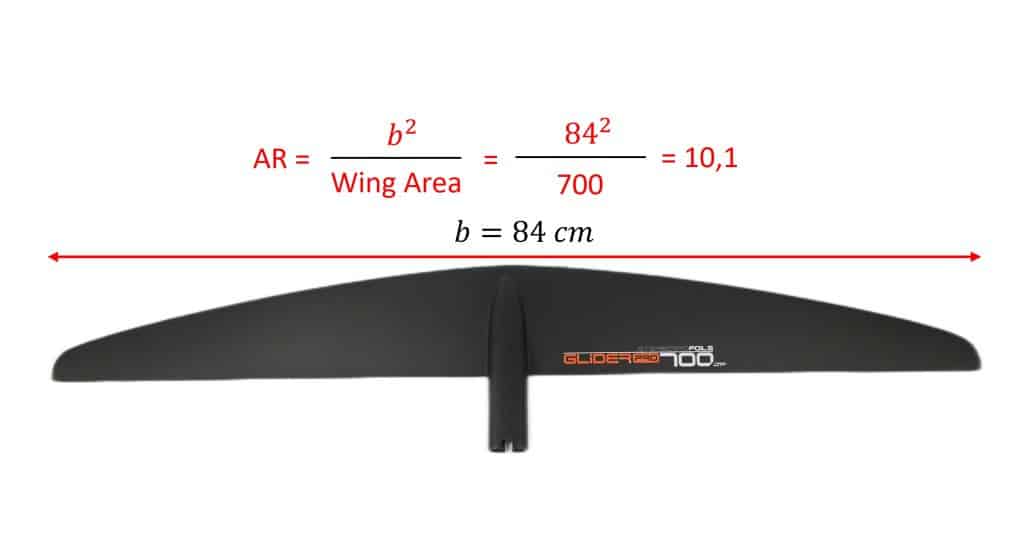
With wing foiling and wind foiling, we often talk about; Low Aspect, Medium Aspect and High Aspect Wings. Despite the fact that there is no ‘hard’ number when a wing falls into which category, we can give a good indication.
A. Low aspect: AR from 3.5 to about 6.
B. Medium aspect: AR from 6 to approx. 8.5
C. High aspect: AR 8.5 to max ca 14
A. Low aspect low-speed flying
Wings with a low aspect ratio often have a relatively large surface area. Often 1400 cm2 or larger up to even 2500 cm2. The large surface ensures that you can get up with little speed (stall speed). An advantage if you want to wing foil or wind foil with relatively small (sail) wings or sails. In addition, these wings are often relatively stable. Due to the large surface area, the resistance is relatively large, so these wings are not very fast. These wings are therefore ideal for learning to foil or cruising back and forth. These wings often have a relatively thick profile, which also provides a lot of lift and a low stall speed.
What is stall speed anyway? We’ve already used the term a few times above. When a wing (of a foil) flies slowly, the pressure on the wing can cause there to be too little upward pressure, causing the foil to sink back into the water. We call this stalling. So when we say that a low aspect wing with a thick profile and a large surface area has a low stall speed, we mean that this wing can ‘fly’ at very low speeds without you ‘falling out of the sky’ with your set.
B. Medium aspect all-round performance
Medium aspect wings often have an average surface area. For wing foiling it is between 800 and 1400 cm2 and for wind foiling it is between 800 and 1100 cm2. The take off (or stall speed) speed of these wings is slightly higher, but the lower resistance makes it easier to build up speed with the right technique. The medium aspect wings are usually faster than the low aspect wings due to the lower resistance.
Medium aspect wings often have an all-round character. For most foilers a sufficiently high final speed, a good stall speed and at the same time sufficiently stable with a nice mix of freeride characteristics. The range of use of medium aspect wings is often very large. The most wings are available in this segment.
C. High aspect for maximum glide efficiency
Just like a glider, high aspect wings have a very high glide efficiency. For wing foiling or wind foiling, this means that you can foil with a relatively small surface area. Because the stall speed is relatively high, it is important to make enough speed to get in the air or keep enough speed to stay in the air.
The high glide efficiency makes these wings very suitable for downwinding or racing, for example. Due to the large wingspan of these wings, the manoeuvrability is a lot less than with medium or low aspect wings. So turning a sharp turn on a short wave is clearly not as good as with a medium or low aspect wing.
High aspect wings are much more nervous during foiling and require better technical skills from the rider. High aspect wings have a thinner profile. To make these thinner wings sufficiently stiff and strong, more exotic carbon types and more advanced production technologies have to be used, which makes these wings considerably more expensive.
High aspect wings don’t necessarily have to be very fast! That depends on the profile of the wing (more on that later).
2. Curve of the leading edge
The curve of the leading edge also has a strong influence on the foil properties of the wing and ultimately the complete foil. In general, the straighter the leading edge, the more difficult it is to make a short turn.
Often the curve of the leading edge is also inherent to the ratio of the wing. Front wings with a low aspect ratio often have a larger curve than high aspect wings. Below are 3 examples of different curves.
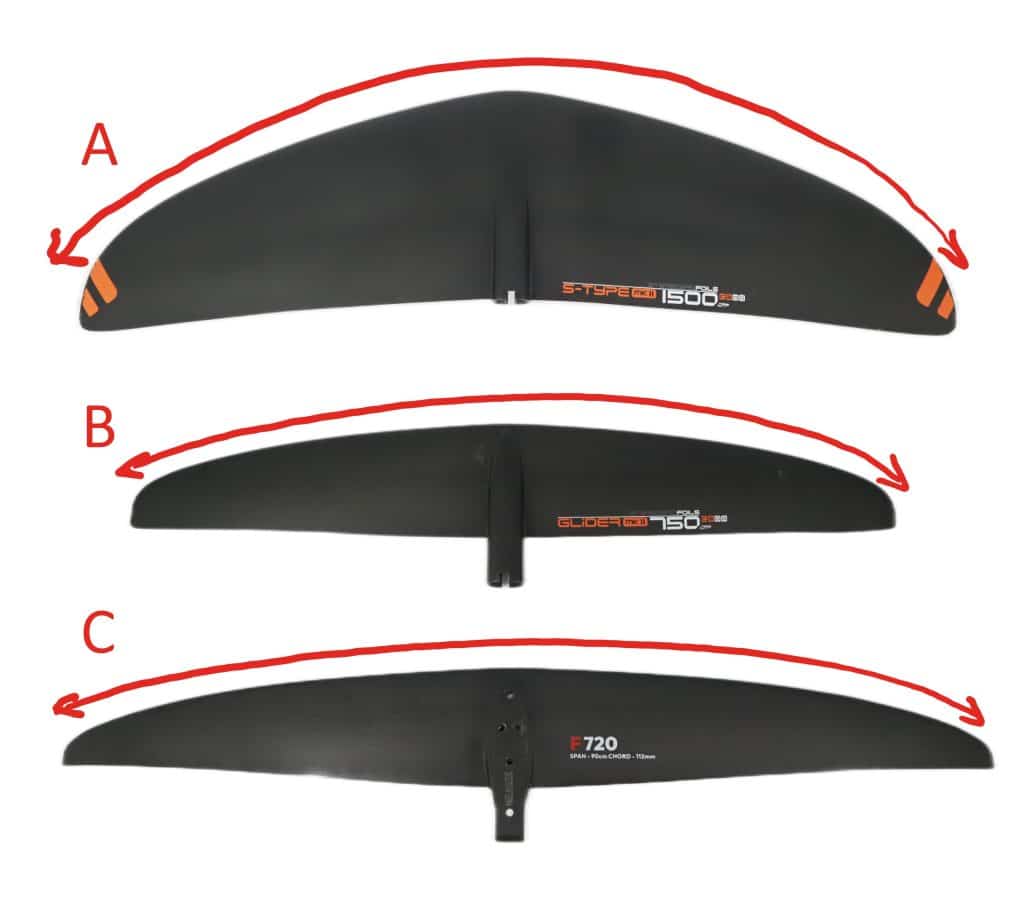
A: Starboard S-type is a typical low aspect wing with a strongly curved leading edge. Good for foiling at low speed and very good manoeuvrability and handling for transitions, for example.
B. The Starboard E-type is a medium aspect wing with a moderate curve in the leading edge. This is a very all-round freeride wing with a good balance between speed, stability and maneuverability.
C. This F4 Foils Slalom Race wing is a wing with a high aspect ratio with a straight leading edge. This is a very efficient wing that is very fast in a straight line. This wing is more technical for foiling. The manoeuvrability of this front wing is poor.
So if you want to play in waves, carving and a friendly character in the foil, then a wing with a (relatively) large curve of the leading edge is more suitable. If straight-line stability or downwinds (often on larger and longer waves) are important, then a wing with a straighter curve is more suitable.
Especially in the medium aspect segment, the curve of the leading edge is an important determinant of the characteristics of the wing. See the 2 examples below. Both fall into the medium aspect segment, but due to the difference in curve, the properties are quite different.
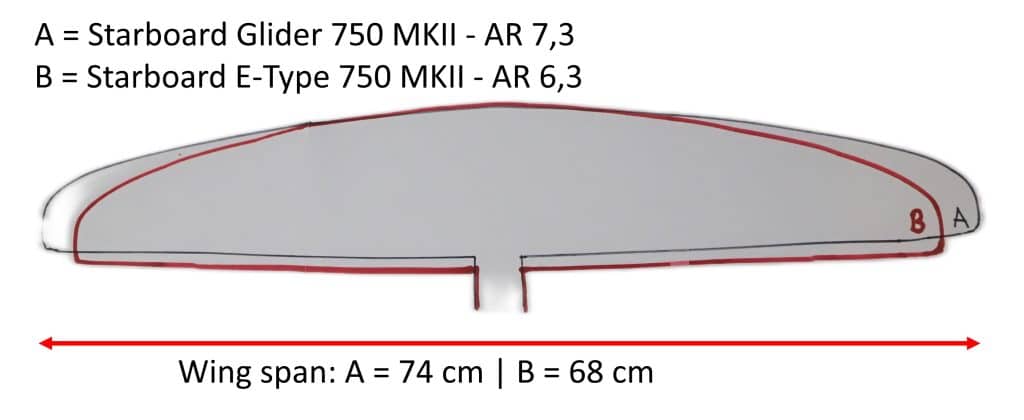
The comparison between the Glider 2 750 and the E-Type 2 750 is a good example of how this works in practice. Both front wings have the same basic design. The only difference is the aspect ratio and the curve of the leading edge. The E-Type feels more agile and playful, but sacrifices a bit of ‘glide’ efficiency. The Glider 2 750 feels more efficient and smooth, but sacrifices a bit of agility and playfulness. Both wings are more or less the same speed.
3. Profile of the wing of a foil
A word about the basic science behind foiling. We can fly/foil through 2 main aspects;
- The under pressure that is created at the top of the wing (at the front of the wing)
- Acceleration and downward movement of the air that pushes the wing up (at the rear part of the wing)
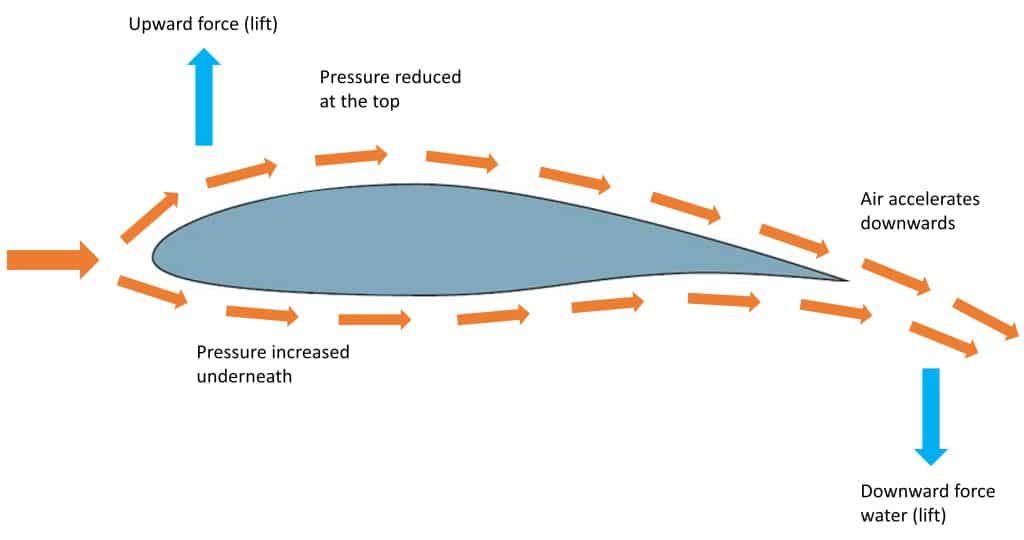
The thicker the profile of a wing, the more under pressure the wing generates. A wing with a thick profile will therefore rise at a lower speed than a wing with a thinner profile.
Often a low aspect wing has a thicker profile than a high aspect racing wing. Precisely from the idea that you want to foil as fast as possible with a low aspect wing, where speed is less important. With a racing wing, on the other hand, a profile is desired that ensures as little resistance as possible and to be able to control the foil even at high speed (read to be able to control the amount of lift).
There is a lot of development in wing profiles. Many of the latest generation wings have a so-called regressive character. The profile of the wings is designed in such a way that a wing with relatively low speed gives a lot of lift – which is useful to get on the foil quickly and with the transitions is also easy to stay in the air -, but where the increase in ‘lift pressure’ decreases as the speed increases. This makes it much easier to keep control at high speed. This is difficult to see ‘on dry land’ whether the profile of a wing has a regressive profile or not.
Stabilizer, the other way around
The Stabilizer has a rounder profile at the bottom, so the back of the foil is sucked down. This provides extra lift in the foil and more importantly provides stability in the foil.
4. Winglet tips
Winglet tips are the curved ends of wings. Some wings have almost flat tips and some wings have large curved tips. In airplanes, you also often see winglet tips at the end of the wings. The winglet tips not only provide higher efficiency but also better course stability. The winglet tips improve efficiency by reducing tip swirls. This is when the water in the high-pressure zone under the wing wants to go around the tip to reach the low-pressure zone above the wing.
So wings with winglet tips have better straight-line stability than wings without the curved tips and are often also experienced as more stable foils. In addition, they often give just that little bit more lift due to the better efficiency.
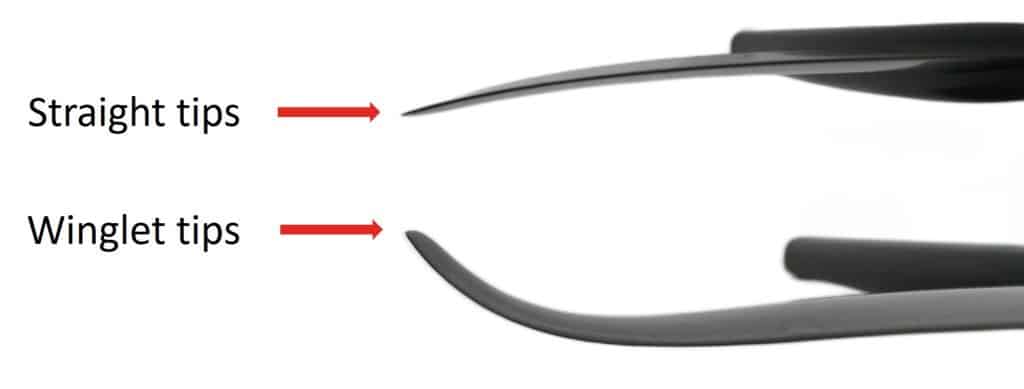
Winglet tips are often used in many freeride and race foils, because straight-line stability is important there.
With foils that are manoeuvrable, you will see that there are no winglet tips on the wings. The lack of winglet tips makes it easier to make short turns. Ideal for carving, wave foiling and freestyle.
Although winglets were a good solution in the past, you see more and more designs that reduce the tip swirls in a different and more efficient way. That’s why the newest planes, like the Boeing 787 Dreamliner, no longer have winglet tips! In the foil world, more and more designers are also moving away from the use of winglets for reasons of efficiency. They are only used to make foils more stable.
Impact stabilizer design
The main function of the back wing or stabilizer is to give stability to the foil. However, the shape of the stabilizer also influences the properties and character of the complete foil.
There are slightly fewer variations in the design of back wings than with the front wings. Below are the most important aspects in the design
- High aspect design: generally provides more lift in the foil and a little more directional stability
- Low aspect design: often makes the foil more playful (manoeuvrability) and transitions easier at low speed
- Winglet tips provide better straight-line stability
- Flat stabilizers make the foil ‘slashy’ – this is a form of manoeuvrability where the foíl can both rotate (around its axis) and carve.
Get good advice and test foils
We hope that we have given you some tips on what to look out for when purchasing a wing foil or wind foil. If you have any questions or advice, please let us know. We have tested almost all the foils we offer ourselves, so we can describe the character of a foil well.
Even better is to experience for yourself what the properties of a foil are and whether the properties suit you. We have a wide range of wing foils and wind foils available for you to test out. Send us a message and we will be happy to schedule a test with you. Take a look at the testing page to see how we are going to work and which foils are available.
Terms Explained
- Leading edge: Is the front (thicker) of the wing
- Trailing edge: is the back (thinner) of the wing
- Aspect ratio: ratio between the wingspan and chord size or surface area of a wing
- Chord size: is the width of the wing (leading edge -> trailing edge)
- Stall speed: The minimum speed that wings need to stay in the air
Different Aspect Ratios in Nature
Take a look in the sky and you will see the different aspect ratios of birds, among other things. An Albatross flies many long distances. Speed and manoeuvrability are less important for this bird. Efficiency is very important to the Albatross. The Aspect Ratio of the wings of an Albatross is between 12 and 15.
For a bird of prey like the Sparrowhawk, speed and manoeuvrability are the most important things to be able to catch its prey. For that reason, the AR of the Sparrowhawk’s wings is a lot smaller, about 5.5.
